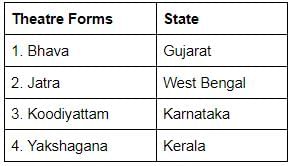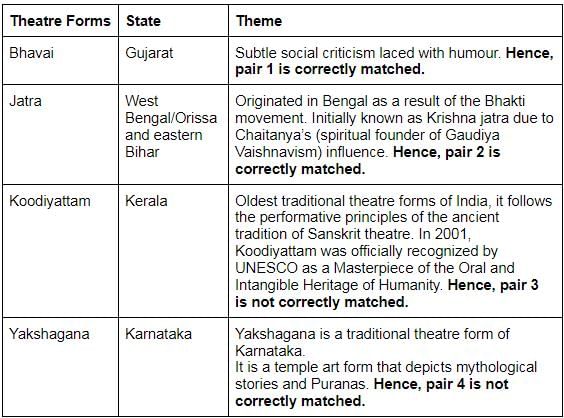UPSC Current Affair: Culture - Italian MCQ
11 Questions MCQ Test - UPSC Current Affair: Culture
Consider the following statements:
1. It is also listed under Particularly Vulnerable Tribal Groups (PVTGs) by the government of India.
2. It is a pre-neolithic, negrito tribe.
3. They are protected under the Andaman and Nicobar Islands (Protection of Aboriginal Tribes) Regulation, 1956.
The above statements most appropriately explain which of the following tribes?
Monpa Handmade Paper Industry is mainly based in which of the following states?
| 1 Crore+ students have signed up on EduRev. Have you? Download the App |
Consider the following statements:
1. Satyamev Jayate was adopted as the national motto of India on 26th January 1950.
2. Satyamev Jayate was taken from the Mundka Upnishad.
3. It is inscribed in the Devanagari script at the base of the Lion Capital of Ashoka.
Which of the statements given above is/are correct?
Consider the following statements:
1. Nendran Bananas are cultivated in Thrissur district of Kerala.
2. The Nendran Bananas got their Geographical Indication (GI) Tag in 2014.
3. IIT-Madras has developed a new product called Banana Grit from the raw Nendran Bananas.
Which of the statements given above is/are not correct?
Consider the following pairs:

Which of the pairs given above are correctly matched?
Consider the following statements about Basavakalyan:
1. He was a 12th century philosopher also known to be the founder of Lingayatism.
2. The Anubhav Mantapa established by Basavakalyan was the school for Lingayats.
3. Kayak and Dasoha were the socio-economic principles given by Basavakalyan.
Which of the statements given above are correct?
Consider the following statements:
1. Pravasi Bharatiya Divas (PBD) is celebrated to commemorate the return of Mahatma Gandhi to India in 1915.
2. The Pravasi Bharatiya Samman Award is conferred to the institutions established by the overseas Indians.
Which of the statements given above is/are not correct?
Consider the following statements:
1. The temple was constructed by King Anatavarman Chodaganga Deva of the Eastern Ganga Dynasty.
2. It is a part of Char Dham pilgrimages.
3. It is also called ‘Yamanika Tirtha’.
The above statements most appropriately describing which of the following temples in India?
Consider the following statements:
1. National Youth Day is celebrated to commemorate the birth anniversary of Swami Vivekanand.
2. The National Youth Festival is organised by the Ministry of Youth Affairs and Sports.
Which of the statements given above is/are correct?
Consider the following statements about Maghi Mela:
1. The Maghi Mela is celebrated to commemorate the forty sikhs who sacrificed their life fighting the Mughals.
2. It is held in the Month of Magh as per the Bikrami calendar.
Which of the statements given above is/are correct?
Consider the following statements:
1. The world’s oldest known cave art is discovered from the Leang Tedongnge cave.
2. The Leang Tedongnge cave is located on the island of Sulawesi, Indonesia.
Which of the statements given above is/are correct?


















